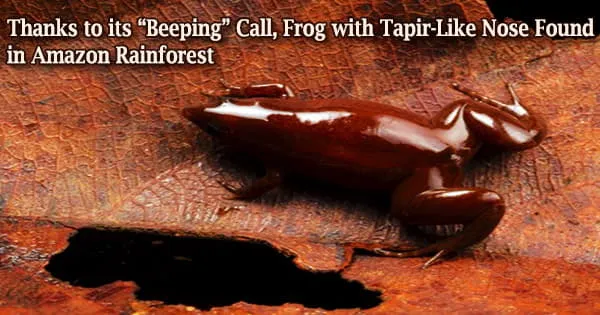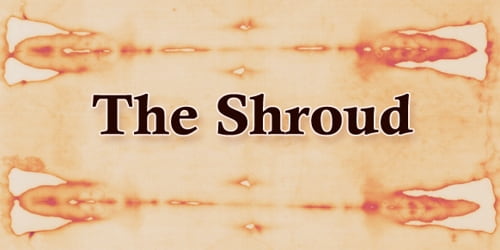There is a little, burrowing frog in Peru’s Comunidad Nativa Tres Esquinas that locals refer to as the “tapir frog” because of its resemblance to the large-nosed Amazonian creature.
But up until today, this frog has eluded scientists. An international research team was able to locate the frog and give it a recognized scientific name and description with the assistance of local guides.
“These frogs are really hard to find, and that leads to them being understudied,” says Michelle Thompson, a researcher in the Keller Science Action Center at Chicago’s Field Museum and one of the authors of a study describing the frog in Evolutionary Systematics. “It’s an example of the Amazon’s hidden diversity, and it’s important to document it to understand how important the ecosystem functions.”
“Frogs of this genus are spread throughout the Amazon, but since they live underground and can’t get very far by digging, the ranges each species is distributed in are fairly small. Since we found this new species in Amazon peatland, it wouldn’t be strange for it to be restricted to this environment. Its body shape and general look seem to be adapted to the soft soil of the peatland, rather than the robust and wider shape of species in other environments,” says Germán Chávez, a researcher at Peru’s Instituto Peruano de Herpetología and the study’s first author.
The tapir frog’s appearance is striking. “It looks like a caricature of a tapir because it has a big blobby body with this tiny little pointy head,” says Thompson. But despite its goofy appearance, it was very difficult to find. “The frogs are tiny, about the size of a quarter, they’re like brown, they’re underground, and they’re quick,” she says. “You know these little frogs are somewhere underground, but you just don’t see them hopping around.”
But while the frogs are hard to see, they’re not hard to hear. “We just kept hearing this beep-beep-beep coming from underground, and we suspected it could be a new species of burrowing frog because there had recently been other species in its genus described,” says Thompson. “But how do we get to it?”
The researchers were taken to peatland areas by local guides who were knowledgeable about the frogs. These wetlands are covered in nutrient-rich grass comprised of decomposing plant debris. As the frogs were most active at night, the team searched then.
Beside the important role of this new species in the food chain of its habitat, we believe that it could be an indicator of healthy peatlands. First, we have to confirm whether it’s restricted to this habitat, but its body adaptations seem to point in that direction. For instance, if the habitat is too dry, the soil would become too hard for a non-robust frog like this one to dig. This would leave our frog with far fewer chances to find shelter and eventually, it would be hunted by a bigger predator. So I think possibilities that this frog would be a wetlands specialist are high, but still need to go further in this research to confirm it.
Germán Chávez
“We had already caught a juvenile our first night in the peatlands, but at 2-3am, we were tired. So, we chose our last night in that site, after three hard nights searching for frogs and snakes, to go to the peatlands exclusively to find those frogs that we heard the first night,” recalls Chávez.
“David Sánchez, one of our coauthors from the Instituto Amazónico de Investigaciones Científicas in Colombia, suggested that once we heard one of these lads calling, we create an imaginary square, perhaps one meter by one meter, and started to dig with our hands in this square to find them.”
“We could hear them underground, going beep-beep-beep, and we’d stop, turn off our lights, and dig around, and then listen for it again,” says Thompson. “After a few hours, one hopped out of his little burrow, and we were screaming, ‘Somebody grab it!’”
“After 15 to 20 minutes of digging and looking for them, I heard Michelle screaming, and to me that could only mean that she and David had found the first adult,” says Chavez.
In addition to finally finding adult specimens of the frogs, the team recorded their calls.
“I am obsessed with recording frog calls, so I decided to record the call first and then continue digging,” says Chávez.
The physical specimens of the frogs, recordings of their calls, and a DNA study of the frogs were all utilized by the researchers to establish that they belonged to a distinct species. They were given the name Synapturanus danta. They are members of the species Synapturanus, and the word “danta” is Spanish for “tapir.”
“Our genetic analyses show this new species belongs to a group that evolved in the western Amazon, where the influence of prehistoric landscapes like the Pebas Lake might have created different wetlands, which originated the diversity we see in Synapturanus today,” says Chávez.
The frogs’ ability to burrow, which made them difficult to discover, suggests that they are an essential component of their peatland habitat.
“They’re part of the underground ecosystem,” says Thompson. “They’re moving down there, they’re eating down there, they’re laying their eggs down there. They contribute to nutrient cycling and changing the soil structure.”
“Beside the important role of this new species in the food chain of its habitat, we believe that it could be an indicator of healthy peatlands,” says Chávez. “First, we have to confirm whether it’s restricted to this habitat, but its body adaptations seem to point in that direction. For instance, if the habitat is too dry, the soil would become too hard for a non-robust frog like this one to dig. This would leave our frog with far fewer chances to find shelter and eventually, it would be hunted by a bigger predator. So I think possibilities that this frog would be a wetlands specialist are high, but still need to go further in this research to confirm it.”
The study’s ramifications stretch beyond than just describing one tiny frog. S. danta was discovered during a rapid inventory led by Field Museum researchers, a program in which social scientists and biologists spend a few weeks in an area of the Amazon to learn about the species that live there, how the locals manage the land, and how they can help make the case for the area to be protected.
“Even though it’s called a rapid inventory, it could take a year or more to plan these things, and then it could take a year or a decade to do the conservation follow-up,” says Thompson. “The rapid part is where you spend a month in the field. And it’s a total whirlwind.”
Rapid inventories rely on the local knowledge of scientists and indigenous populations.
“The most special thing about rapid inventories is the group of people you’re with,” says Thompson. “There are people sharing their traditional knowledge about the land that they’re from, people from universities, museums, governments. Bringing all these people with different backgrounds together is probably the best space to learn in.”
This quick census was part of a bigger conservation effort by the Keller Science Action Center and its collaborators in Peru’s Putumayo Basin.
“The Putumayo Corridor spans from Ecuador, Colombia, Peru, and down to Brazil, following the Putumayo River,” says Thompson. “There’s very little deforestation, and it’s also one of the last free-flowing rivers that has no current dams. There’s like a huge conservation opportunity to conserve the whole corridor, watershed, and surrounding areas. This tapir frog is another piece of evidence of why scientists and local people need to work together to protect this region.”
















